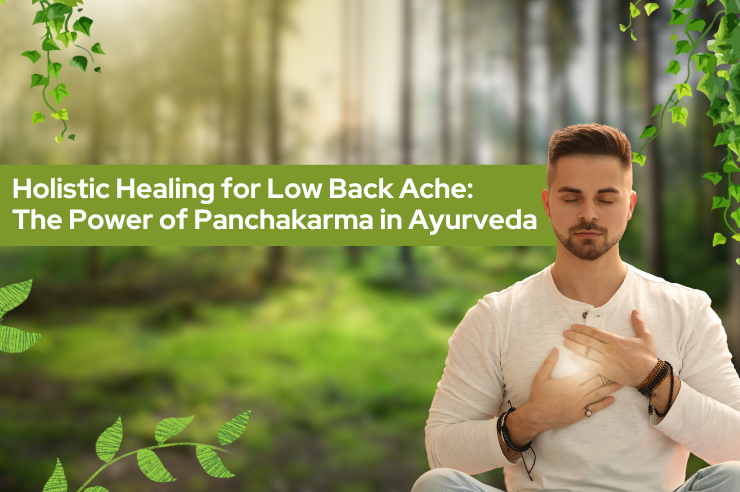Back ache is a pervasive health issue that transcends age, occupation, and lifestyle, affecting millions of people globally. It is the fifth most common reason for the physician visit these days. Traditional medical approaches typically address back pain through pharmacological interventions and surgical procedures, which may not always target the root causes of the condition. This is where Ayurveda, the ancient holistic healing system, offers a unique and effective approach for back pain. This blog will explore the Ayurvedic understanding of back ache, which is an Ayurvedic treatment for back pain, discussing specific therapeutic modalities and their physiological impacts to offer a comprehensive perspective on this age-old healing tradition.
Understanding Low Back Ache
Low back pain occurrence is increasing day by day due to sedentary lifestyle and unhealthy work patterns of young adults. Pressure on the intervertebral disk is highest in sitting position, 30%less in standing and 50% less in lying down. So that longer sitting will be more uncomfortable than standing and walking. In this corporate era people doing long hours of sitting jobs are more prone to get low back pain.
Low back ache can be categorized into acute, sub-acute and chronic pain. Acute pain typically results from sudden injury or strain and lasts for a few days to weeks (lasts less than 6 weeks), Sub acute pain lasts for 6-12 weeks and chronic pain, persists for more than three months and may be due to conditions such as degenerative disc disease, spinal stenosis, or osteoarthritis etc.
Common Causes for Low Back Pain Includes
- Heavy physical work
- Poor posture
- Unaccustomed weight lifting
- Prolonged periods of static work posture
- Obesity
Causes Related to Spine Includes
- lumbar spondylosis
- Lumbar stenosis
- Infection
- Tumour
- IVDP
Common Symptoms Include:
- Persistent dull ache or sharp pain
- Muscle stiffness or spasms
- Radiating pain to the lower limbs ( sciatica)
- Reduced flexibility and mobility
- Transient numbness and paraesthesia in the dermatome of the nerve roots
Ayurvedic Perspective on Low Back Ache
According to Ayurveda, low back ache is primarily linked to an imbalance in the Vata dosha. Acharya says that there is no shoola (pain) without the vitiation of vata. Vatasya upakrama and vata vyadi chikitsa can be adopted in the treatment of vatavyadi. Ayurvedic treatment for low back ache mainly aims at reducing the pain and stiffness and arresting the process of degeneration and reoccurrence.
Panchakarma For Low Back Ache
- Snehana: It includes both internal and external snehana treatments. Snehana is done in the nirupasthambavastha of vata .In which there is no association of ama present. To achieve the niramavastha rookshana procedures are done in the first place.Internal snehapana comprises of medicated oil and ghee intake that has vatahara properties.
- Swedana (Herbal Steam Therapy) :Alleviates vata dosha, softens the body and disintegrates the adhered morbid materials.Swedhana is indicted for samavatavyadhis. Procedures including patra pinda sweda, choorna pinda sweda, nadi sweda, parisheka sweda are done here.
- Mrudu samsodhsana : For the elimination of doshas snigdha virechana is advised in vatavyadi. Eranda taila is recommended for the nitya virechana in vatavyadi.
- Basti (Medicated Enema Therapy): Basti is one of the most crucial treatments for Vata disorders and is highly effective for chronic low back pain. Medicated oils or herbal decoctions are administered as enemas to cleanse the colon and balance the Vata dosha. Basti helps to remove accumulated toxins, reduce inflammation, and nourish the tissues, offering long-term relief from low back ache.
- Kati Basti (Localized Oil Treatment): In this treatment, a reservoir of warm, medicated oil is placed on the lower back for a specific duration. This act as both snehana and sewdana. Helps to increase the blood flow, reduces inflammation
- Pizhichil (Therapeutic Oil Drip): Pizhichil, also known as “Thaila Dhara,” involves the continuous pouring of warm, medicated oil over the body. This therapy combines the benefits of Abhyanga and Swedana, providing profound relaxation, improved circulation, and relief from pain and stiffness.
Yoga Asanas for LBA
Along with the treatments exercises and yoga asanas that helps to strengthen the paraspinal muscles contributes to the pain relief.
- Pavana mukthasan
- Bhujangasan
- Paschimottanasan
- Makarasan
- sashankasan
Conclusion
Low back ache can significantly impair one’s quality of life, but Panchakarma treatments offer a holistic and effective solution rooted in Ayurvedic wisdom. For those suffering from back pain, Ayurveda offers a promising and time-tested approach. Consulting an experienced Ayurvedic practitioner can provide a personalized treatment plan that aligns with individual health needs, paving the way for a pain-free, balanced, and healthier life.

